What groups did the Nazis deem unfit to belong to the Aryan “master race�
The masterpieces stolen by the Nazis
(Image credit:
Drove Walker Art Center, Minneapolis
)
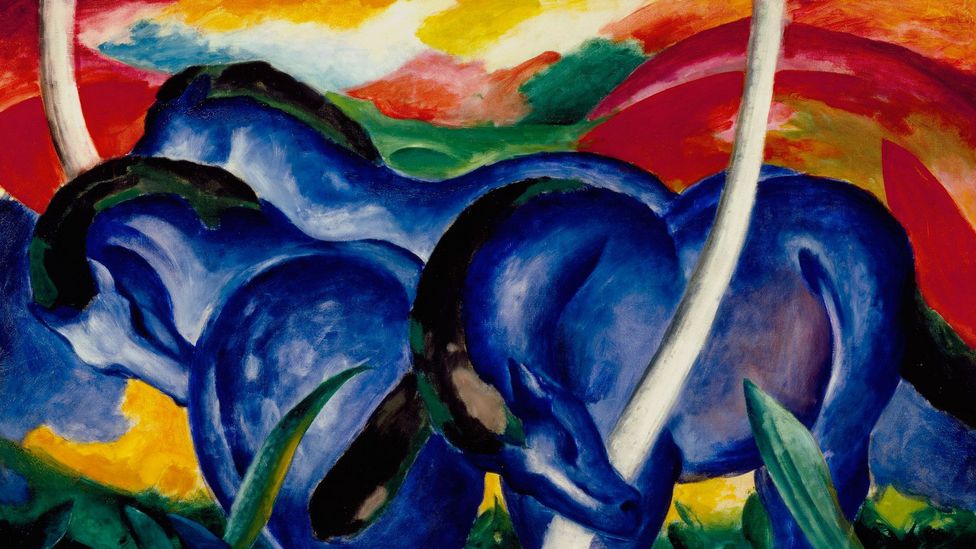
The journeys of looted artworks take powerful stories that are being explored in a new exhibition, writes Diane Cole.
W
Within the long history of art resides the nearly-every bit-long history of looted art. We are dazzled by these treasures from faraway lands and ancient eras, even as we remain mostly blind to their provenance. Usually left unmentioned is their means of acquisition – all too often, brutally uprooted from their original homes and owners every bit the spoils of war, colonial conquest, or at the dictate of despots.
More than like this:
- The art subconscious from Nazi bombs
- The Nazi art hoard that shocked the globe
- Recovering what the Nazis stole
Until now. Nosotros're reading more than ever about international disputes over buying and restitution, including allegations this week that Switzerland's largest art museum might exist displaying up to xc works with problematic provenances. Also causing controversy recently are stories focusing on the origins – and the fate – of the Benin Bronzes, at to the lowest degree some of which are in the process of finding their way back to Nigeria and Autonomous Republic of Congo from the many countries and museums to which their colonial rulers dispersed them, including Kingdom of belgium, Germany, the British Museum and New York's Metropolitan Museum.
Such histories of theft and rescue are made more than real in a powerful new exhibition at New York's Jewish Museum, Afterlives: Recovering the Lost Stories of Looted Fine art. And they are presented through treasures both creative and cultural.
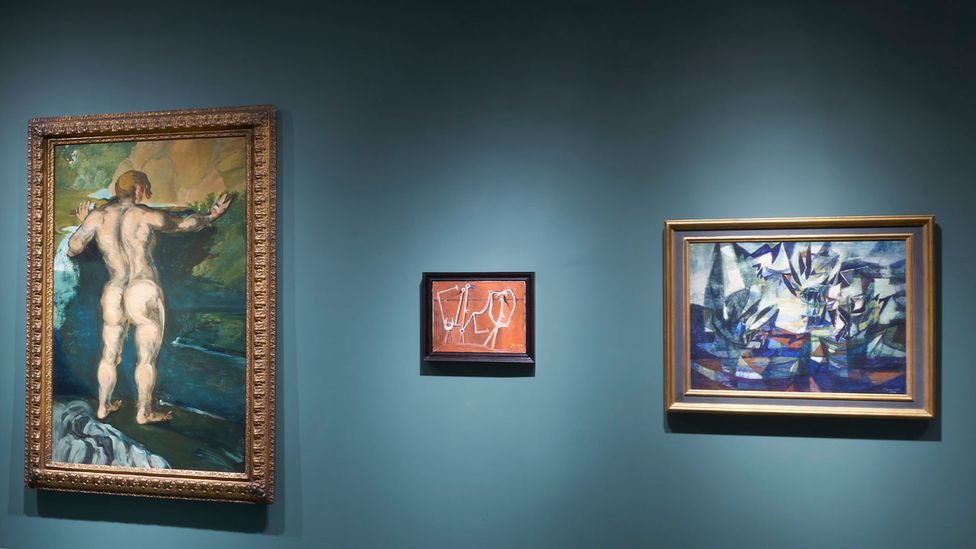
Löwenstein's 1939 Composition (correct) appears near paintings by Paul Cézanne (Bather and Rocks, left) and Pablo Picasso (Group of Characters, middle) (Credit: Steven Paneccasio)
In the opening galleries, we view one extraordinary canvas after another past Pierre Bonnard, Marc Chagall, Paul Cézanne, Henri Matisse, Camille Pissarro and other great European modernist painters, each with a story to tell of pillage past the Nazi regime. Many of these works were seized from collectors and artists who happened to exist Jewish; others the Nazis confiscated and slated for oblivion considering they did not conform to Hitler's narrow definition of what Aryan art should be – that is, representational and wholesome in their subject thing, as opposed to the ofttimes abstract, expressionistic compositions that characterised so many modernist works, which they labelled as "degenerate".
Then there are the cute arrays of delicately crafted ritual silverish objects that once graced the homes and synagogues of the Jews of Europe. They can and should exist admired for their craft. Only in the context of this bear witness, they also speak even more powerfully to their rough seizure from their original owners who in one case wielded them to welcome the Sabbath, celebrate the holidays, and detect the milestones of life and death, all according to Jewish tradition. You cannot walk through these galleries without thinking of the sense of despoliation experienced past so many people of other cultures throughout history. The emotional pull is visceral.
These objects are the material survivors of the Jewish communities of Europe, each ane with a distinct story, an "afterlife" of survival, to reveal. Yet taken as a whole, these tales also attach to what nosotros might recall of as a new kind of archetypal journey, 1 that follows the fate of each work, from the original uprooting of cultural theft to displacement to eventual rescue and restitution.

Franz Marc's The Big Blue Horses (1911) was the inspiration for US poet Mary Oliver's 2014 book Blue Horses (Credit: Collection Walker Art Centre, Minneapolis)
The divergent roads to such an afterlife are axiomatic from the moment y'all enter the exhibition. You're greeted, first, by the gorgeous sheet past the High german Expressionist artist, Franz Marc. The Large Blue Horses, painted in 1911, depicts three vibrantly blue horses, clustered sensuously together in the foreground, with the hillside backside them washed in splashes of blue, cherry and green. Although Marc died fighting for Frg in World War One, Hitler banned his work.
But it escaped the Reich's reach because in 1938 its German owner sent it to London, to exist included in an "anti-Hitler" show, and from in that location it travelled as office of some other exhibition, 20th Century Banned German Art, to the U.s., where an American buyer purchased it for a collection that is now office of the Walker Art Eye in Minneapolis. It seems thematically fitting that the painting appears hither, on loan once over again.
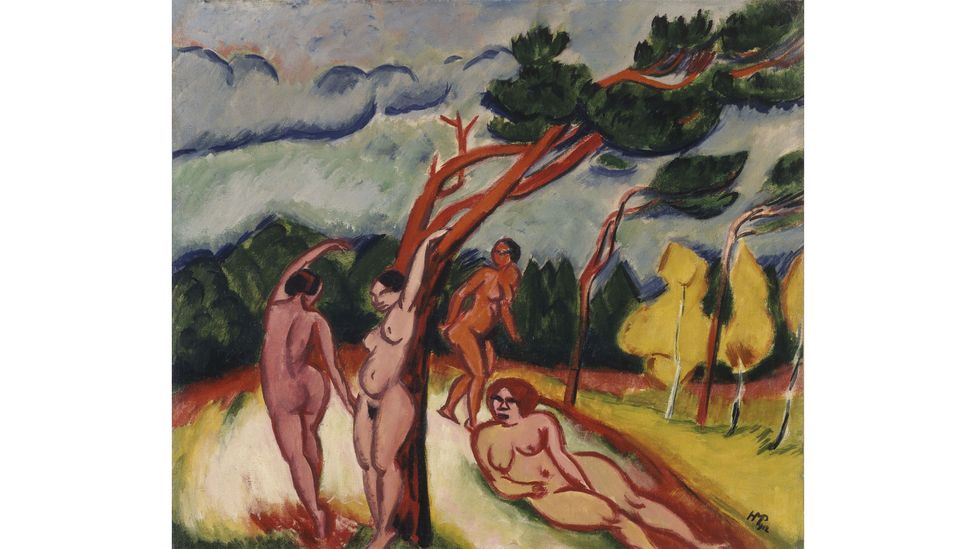
Max Pechstein's 1912 painting, Nudes in a Landscape, was restored to the heirs of its Jewish owner in 2021 (Credit: Estate of Hugo Simon)
Virtually that canvas is a lush, evocative Max Pechstein painting from 1912, Nudes in a Mural, an exuberant canvas that just this summer was returned by the French regime to the heirs of the German-born Jewish broker and art collector Hugo Simon. Its murky journey is emblematic of the often long and twisty road travelled by looted fine art to eventual restitution.
Simon's journeying, too, was precarious. He fled Berlin for Paris when Hitler came to ability in 1933, and afterward France fell to Germany in 1940, he escaped again, this time to Brazil. But the painting was left behind in Paris and seized by the Nazis. It did not turn up again until 1966, institute in storage at the Palais de Tokyo in Paris – all the same how it landed there remains a mystery. From 1998 on, it was housed at the modernistic fine art museum in Nancy, France.
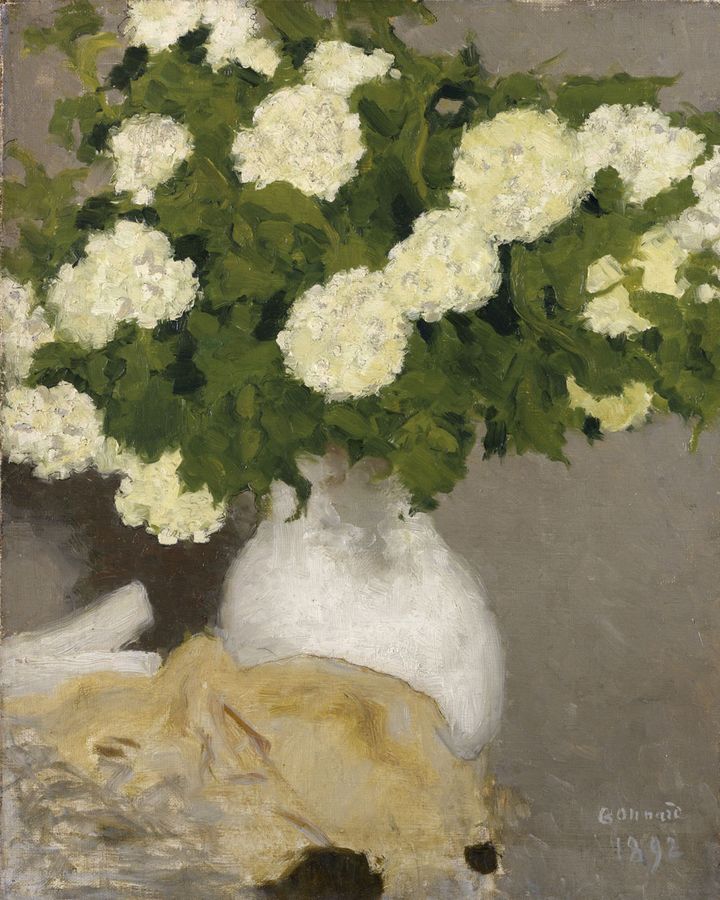
Still Life with Guelder Roses (1892) by Pierre Bonnard, who refused to paint a portrait of the French collaborationist leader during WW2 (Credit: The Nelson-Atkins Museum of Art)
Another route to restitution is exemplified in an adjacent canvas. The green, yellow, white Impressionist-style 1892 painting past Pierre Bonnard, Even so Life with Guelder Roses, was one of 2,000 pieces stolen by the Nazis from a single collector, David David-Weill, the French-American philanthropist who had headed the cyberbanking house Lazard Frères. This canvass was returned to him in 1946, shortly after it was recovered by Allied forces amongst the many works hidden by the Nazis in an Austrian salt mine.
Hard journeys
The relative smoothness of that recovery makes restitution sound easy, right? Just take a few steps into the next room, and yet another work in the exhibition in one case once again emphasises the ongoing, maybe unending piece of work of restitution, in the class of a 1939 Cubist geometric canvas by the German Jewish artist Fédor Löwenstein, that is only now in the process of existence returned to heirs of its original owners past the French authorities.
Its story likewise brings home the randomness of both survival and restitution. Afterwards its seizure, the work had been relegated to a storage space at the Jeu de Paume Gallery in Paris that was known every bit "The Room of the Martyrs". Here, German officers could select and walk off with stolen masterpieces of their choice; those that remained were oft deemed degenerate and slated for destruction. Just this one slipped through the cracks and survived, perchance with the help of Rose Valland, the art historian who secretly kept track of the approximately 20,000 works brought there, records that played a cardinal function, mail service-war, in recovering much of the stolen fine art.
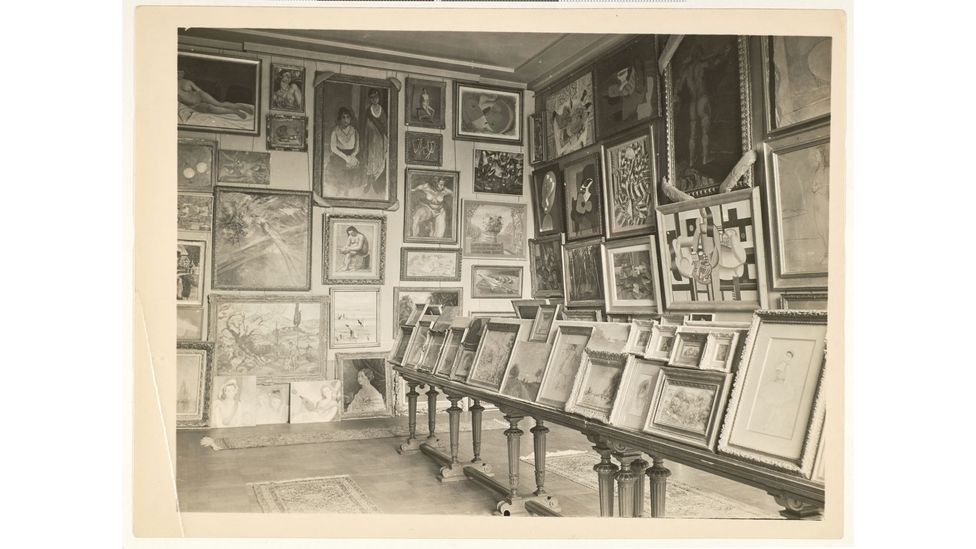
The Room of Martyrs, a storeroom for art banned by the Nazis, at the Jeu de Paume gallery in Paris (Credit: The Jewish Museum)
Yet despite her efforts, Valland could not save them all, alas. A blackness and white photograph of the room, probably from 1942, shows paintings by André Derain and Claude Monet, amid others, that did non plough up mail-war and nearly probable were destroyed. It's impossible not to plough from this photo with a sense of gratitude for the presence of the glorious works on display here by Paul Cézanne, Pablo Picasso, Henri Matisse, and Marc Chagall, among others.
Nor are viewers immune to ignore the lives and fates of the families to whom all these textile possessions at one time belonged. A serial of one-time family unit photos is lined upward on what seems similar a living room mantlepiece, intimating what a normal middle-grade Jewish family life looked like before the Nazis forced them out. And and so, following the Nazi timeline of horror, comes a collection of portraits and drawings made in secret, and then hidden, past artists interred in Nazi concentration camps.
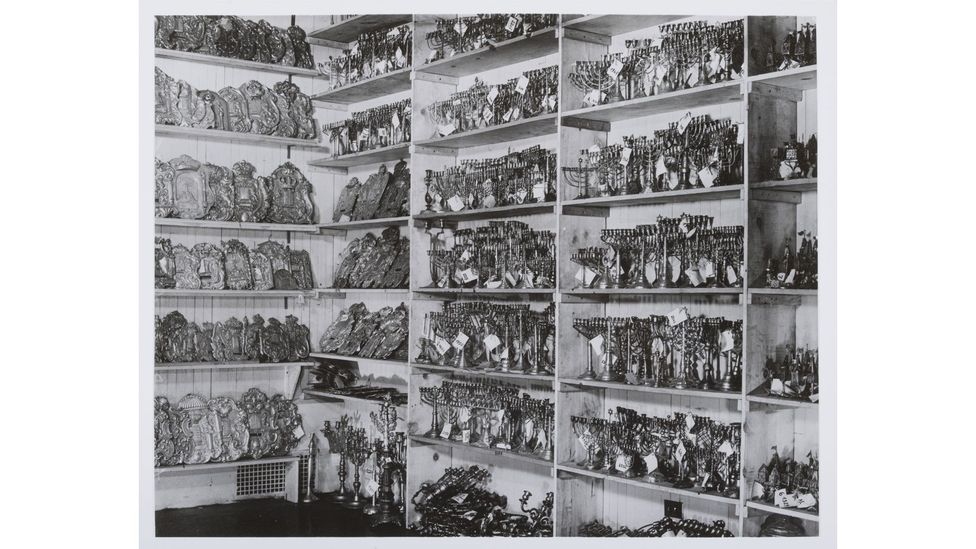
Ritual objects were rescued by Jewish communities as part of a wider salvage effort (Credit: The Jewish Museum)
Perhaps it's no wonder that walking through the galleries, I often felt immersed in a globe turned topsy-turvy by theft, never more so than equally I gazed at the vitrines of Jewish ritual objects – Kiddush cups, Sabbath candle sticks, Torah pointers, and other holy objects – lined upwardly alongside each other as if for a massive warehouse auction, with no community, perhaps no person, alive to claim them. That is, until the surviving Jewish communities exterior of Europe – including the Jewish Museum in New York – stepped in after the war to help rescue the many orphaned objects. All the formalism works on display in this exhibition institute their own afterlives as role of the Museum'due south permanent collection, a function of that massive endeavour to relieve the remains of European Jewish culture.
Looking forward
That the legacy of stolen art and cultural objects as well leaves ghostly afterlives in subsequent generations is the subject of the terminal department of the exhibition: new works deputed by four young contemporary artists living in Israel, Berlin, and Brooklyn: Maria Eichhorn, Hadar Gad, Dor Guez, and Lisa Oppenheim.
Each of these artists approaches this history from a different perspective. Conceptual artist Eichhorn immerses us in the very work of recovering, locating, and returning looted objects. She does so by surrounding us with actual cases of archival papers, ledgers, reports, books, and on and on, all needed to verify, certify, analyse, authenticate each artifact, each item. Further intensifying the sense of existence thrust into the work itself is the audio backdrop of an ongoing, non-finish recording of the voice of philosopher Hannah Arendt. She is reading various memos she wrote in her chapters as a managing director of the agency tasked with the lamentable but urgent goal of sorting through the massive crates of materials that were recovered.
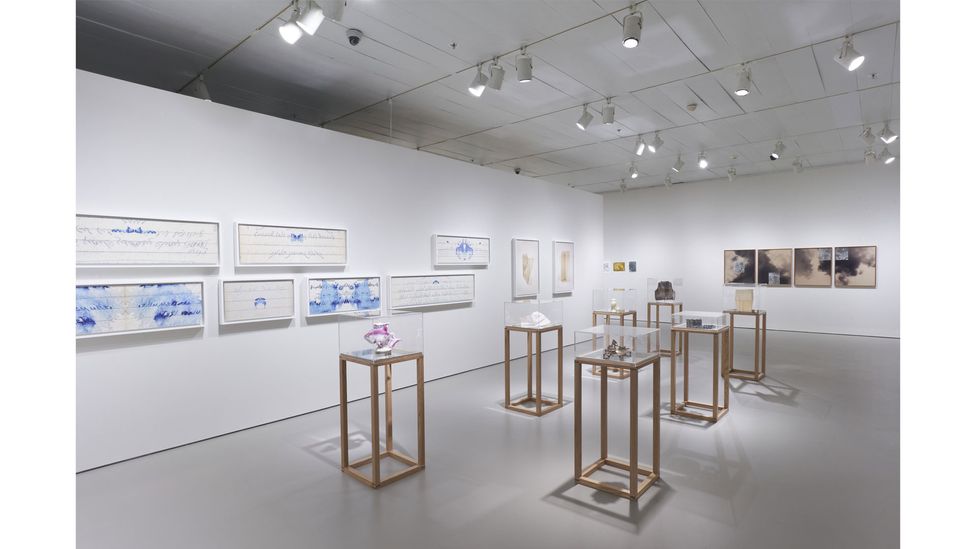
Dor Guez'due south installation is based on a manuscript from his family unit's archive that belonged to his paternal grandfather, a Holocaust survivor (Credit: Steven Paneccasio)
In his installation, Dor Guez, the son of a Palestinian mother and a North African Jewish father, creates a museum-manner display of objects, documents and prints to bring to life again the multiplicity of losses of his family'south Judeo, Tunisian, and Standard arabic languages and culture. Hadar Gad's powerful large-scale, dream-like collage paintings are based on historical photographs of the backwash of the destruction of Jewish belongings by Nazi soldiers. Finally, Lisa Oppenheim bases her series of mysteriously clouded photo-collages on the merely remaining image of a still-life painting – by the Franco-Flemish painter Jean-Baptiste Monnoyer – that disappeared afterwards its confiscation by the Nazis from a Jewish household in Paris.
These, and so, are the afterlives that remain. The emotional bear on of the exhibition is overwhelming: joy and gratitude at the rescue of and then many exquisite artworks; grief at the losses endured past the destroyed Jewish communities of Europe; and finally comfort in the knowledge that their stories exercise suffer. There might even be a blink of hope that these narratives could also bring some perspective in resolving the many ongoing restitution cases around the earth. In the concurrently, the archetypal journeys of the world'south looted artworks continue.
Afterlives: Recovering the Lost Stories of Looted Art is at New York'due south Jewish Museum until 9 January, 2022.
If you would like to comment on this story or anything else you have seen on BBC Civilisation, head over to our Facebook folio or message us on Twitter .
And if y'all liked this story, sign up for the weekly bbc.com features newsletter , called The Essential List. A handpicked selection of stories from BBC Future, Culture, Worklife and Travel, delivered to your inbox every Friday.
hilliardbeirl1968.blogspot.com
Source: https://www.bbc.com/culture/article/20211123-the-masterpieces-stolen-by-the-nazis
0 Response to "What groups did the Nazis deem unfit to belong to the Aryan “master race�"
Post a Comment